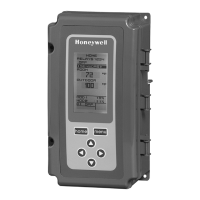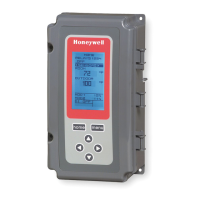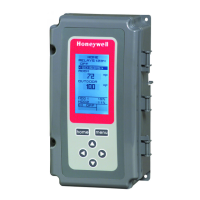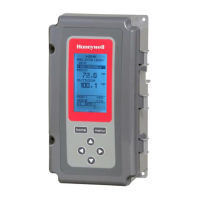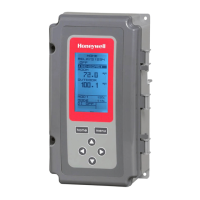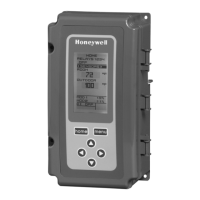T775P SERIES 2000 ELECTRONIC STAND-ALONE CONTROLLER
11 62-0256—11
PROGRAMMING OVERVIEW
The controller must be programmed before being placed
into service.
IMPORTANT
During programming, the controller is live at all
times. For example, the contacts may open and
close when adjusting the setpoint.
The programming process uses a hierarchical menu
structure that is easy to use. You press the and
arrow buttons to move forward and backward through the
menus.
NOTES:
1. The T775P controller interface is intuitive. You
may want to use these procedures simply as
a reference to locate the particular option or
parameter of interest.
2. The menus can display only those relays that
are defined in Setup (see “1.3.1. Number of
STAGES” on page 15). For example, if you
configure only one relay, then only one relay
displays on the appropriate menus.
3. If you press the HOME button or there is no
keypad activity for four minutes, you exit Pro-
gram mode and return to the home screen.
4. If you press the MENU button, you exit
Program mode and return to the menu.
Setpoint
The following describes the function of the setpoint for
heating and cooling. One setpoint is programmed and is
used by all the outputs (stages).
Heating Mode Setpoint
In heating mode, the relay de-energizes when the
temperature rises to the setpoint. When the temperature
drops to the setpoint, the relay energizes.
Cooling Mode Setpoint
In cooling mode, the relay de-energizes when the
temperature falls to the setpoint. When the temperature
rises to the setpoint, the relay energizes.
Setpoint High Limit
You can set an irreversible setpoint high limit maximum
value for the displayed setpoint value.
Adjust the setpoint to the desired maximum setpoint.
Then, simultaneously press the HOME, , and buttons
and continue to press all three buttons for five seconds to
set the setpoint high limit maximum to this value.
NOTE: You must press all three buttons at exactly
the same time for this action to occur.
IMPORTANT
1. This action sets the maximum setpoint value for
all outputs to the setpoint high limit maximum.
2. Setting the high limit setpoint maximum is irre-
versible. If you perform the action inadvertently
and this setpoint adversely affects the control of
your system, you must replace the controller.
Stages (Relays) and Pump Output
The T775P model can be used to stage multiple relays
from a singe heat or cool setpoint. The number of stages
can be freely chosen, limited by the number of relays
available (up to 12 relays [11 if using the pump output]
using two T775S expansion modules).
The T775P provides a pump output using the last of the
four SPDT relay outputs on the T775P controller. When
T775S Expansion Modules are used, the configurable
pump output is the last relay output of the last expansion
module. See Table 4.
IMPORTANT
If the stage configuration is changed (e.g., the
number of stages [relays] changes) then you
must use Setup mode to re-select the pump
stage. See “1. Setup” on page 12.
Staged Operation
Staging occurs as illustrated in Fig. 18 for a Heat setpoint
of 200°F and a throttling range of 20°F when the Integral
value is zero (0). When the Integral is not zero, then the
actual temperatures at which stages energize and de-
energize will vary from this example; see “1.3.3.2.
INTEGRAL” on page 17.
NOTE: A non-zero integral causes the control to
move toward the setpoint value.
Fig. 18. Staging Behavior
(when effective Setpoint = 200°F).
Sensor Control
Sensor A (supply) or Sensor C (return) must always be
the controlled temperature. In Reset applications, Sensor
B must always be the controlling temperature (e.g. the
Table 4. T775 Stages and Pump Output.
Maximum
Stages
with no Pump
Output
Maximum
Stages
with Pump
Output
Relay #
Used for
Pump
Output
T775P 4 3 4
T775P & one
T775S
878
T775P & two
T775S
12 11 12
M24297A
THROTTLING RANGE
STAGE 2 ON
STAGE 3 ON
STAGE 1 ON
-25%
STAGES
HYST.
75%
205°F 185°F
0%
200°F
25%
195°F
STAGE 4 ON
50%
190°F
STAGE 1
STAGE 2
STAGE 3
STAGE 4
STAGE ENERGIZES STAGE DE-ENERGIZES
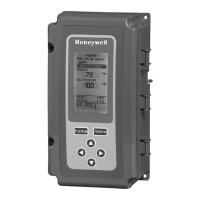
